Influencer Marketing Trend Report 2021
Influencer marketing trends change constantly in reaction to social media, consumers, and influencers themselves. Stay up-to-date with this trend...
Reporting is crucial to measuring influencer campaign performance and ROI. This post breaks down what goes into an influencer report and the metrics to track.


How exactly do you measure the “success” of your influencer marketing efforts?
It's a bummer when a brand crushes a campaign but doesn't have the tools to present the "hard numbers" to their teams. This is especially true if you need budget or buy-in to scale your campaigns.
But we get it: reporting positive outcomes from influencer marketing can be complicated.
"Show me the data” is the mantra of marketers today. Chances are you're already tracking a slew of KPIs across multiple channels. Adding influencer marketing metrics into the mix can be daunting.
We totally get it! Listen: brands should feel confident about their marketing data and campaign performance. That's why it's so important to master the art of influencer reporting.
And in this post, we'll teach you to measure your results effectively!
Skip to Section 👇Influencer Metrics and KPIs to Report On (and How to Track Them) |
Before you can start reporting on influencer performance, you need to know what to track.
Enter your metrics and KPIs. You know, the numbers the C-Suite is always asking about.
Just note that tracking influencer marketing ROI isn’t a one-size-fits-all affair. Priority metrics vary from brand to brand based on the goals you've set.
For example, are you focused on getting a specific amount of content? Your KPIs should reflect that.
Let’s review the most common metrics related to influencer marketing measurement below.
Engagement refers to social media interactions such as comments, shares and and “Likes.”
These details are front and center on most influencer posts. This applies to content on TikTok and Instagram alike.


Source(s): @abbeyyung / @madagraviet
Engagements highlight audience touchpoints and how your creators’ content was received. More interactions mean more eyes on your brand.
Digging into comments and replies, you can put engagements into context via sentiment analysis.
For example, a flood of positive comments indicates that your influencers’ audience is relevant. You might also learn why people are excited about your product and if they intend to buy them outright.
On Instagram, metrics such as “Likes” and comments are public. Keep in mind that some Instagram influencers do hide their engagement on promotional posts.
On TikTok, metrics including plays, comments, saves and shares are all public.
Assuming their numbers are public, you can calculate an influencer's engagement rate yourself. Here’s a simplified formula to help:
(# of interactions on a post / # of followers * 100) = engagement rate (%)
Your brand might be satisfied with public metrics as far as engagement goes.
That said, you could be missing out on eye-opening campaign data.
How so? Let’s say you want to dig deeper into data points related to Instagram impressions and reach. If you don’t have full access to your influencers’ content, you don’t have full access to their analytics.
For example, an influencer’s personal analytics can break down the total number of accounts reached. You can also see how many of their followers versus non-followers were reached. These numbers are impactful for your influencer reports when a piece of content goes viral.
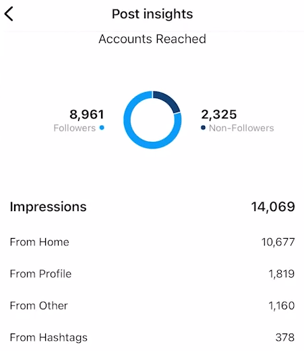
Source: YouTube
As a result, calculating accurate impressions and reach means having a direct line to your creators.
Note: if you’re not using an influencer platform (like Statusphere!) that tracks these on your behalf metrics, you’ll have to reach out to creators for them. Alternatively, whitelisting on Instagram and TikTok provides brands access to creators’ post data. Below is a snapshot of influencer data in the Statusphere dashboard alongside your brand's rights-ready content.
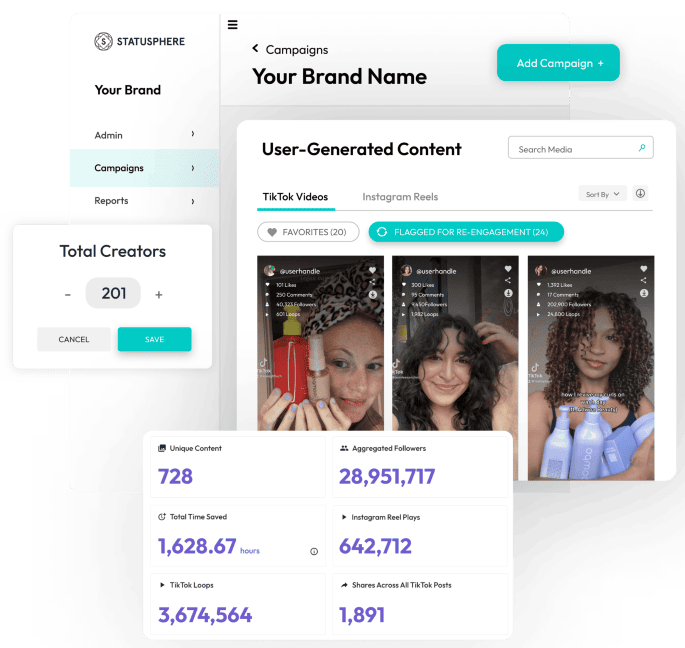
This refers to how many pieces of influencer-generated content your campaign produces.
How many posts you earn can range from a handful to hundreds (or even thousands). This really depends on factors such as:
Content earned is a key metric for influencer campaign reporting. It’s an easy KPI to overlook, too.
Some teams are obsessed with measuring performance data alone. The reality, though? Each piece of unique creator content you earn is arguably more important than individual post “results.”
Consider how you can repurpose campaign content across your marketing channels. This includes product pages, emails and ads. Not to mention content to repost to your own social platforms.
This highlights the value of creators and new opportunities to maximize the results of your content.
Thankfully, measuring earned posts is easy!
If you’re working with a select few creators (or are paying for individual posts), the numbers are already in front of you. Then, monitor #hashtags and @mentions to uncover influencer and user-generated content.
Below is an example from Pacifica Beauty. The brand has a general hashtag to monitor tagged posts on Instagram. They also have campaign-specific hashtags like #activistmascara tied to influencer posts on TikTok. See how that works?
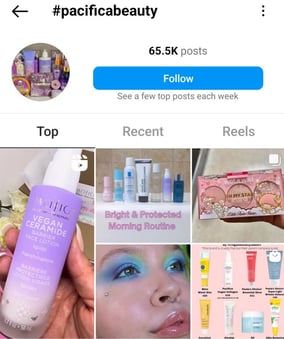

Traffic refers to visitors to your website funneled from your influencer campaigns.
No huge surprises here — traffic is traffic!
The endgame of any given marketing campaign is to generate leads, right?
Traffic highlights how many leads your influencers send to your storefront. An uptick in on-site or product page traffic following an influencer campaign is an indicator of success.
Traffic might seem like a straightforward metric to track. In most cases, it is.
But with influencer marketing campaigns, traffic is kind of complicated.
For starters, the modern customer journey is anything but linear. People are bouncing between multiple platforms and pieces of content before visiting your site.
Some shoppers might go directly from an influencer post to your storefront. The majority, though? They’re going to browse social media, read reviews and maybe even shop around some more.
The takeaway? Influencer campaigns are a brilliant way to make touchpoints with your target audience. Traffic alone doesn’t tell the whole story of measuring those touchpoints.
That’s why we recommend looking at traffic trends both during and following influencer campaigns. Doing so encourages you look at your campaigns more holistically. For example, peek at your Google Analytics to see where your social traffic is coming from.
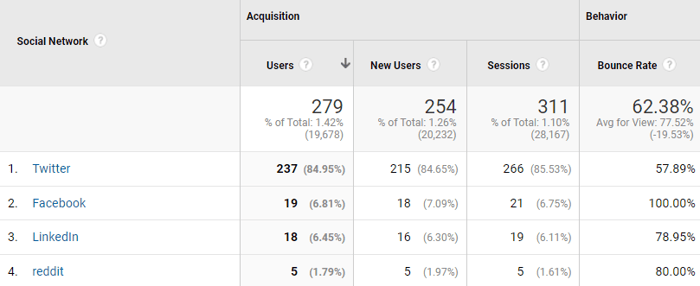
Note: ongoing changes to Google Analytics and cookies may make it more difficult to track social traffic in the near future.
Sales refer to products purchased as the result of an influencer campaign or promotion.
We encourage brands to think of sales as a welcome byproduct of their influencer campaigns.
Again, marketing campaigns are about generating leads. Influencers tend to attract high-quality leads because they speak to your target audience. Like, literally.
Correlating campaigns with an uptick in sales can confirm that your awareness campaigns are working.
Much like traffic, measuring influencer sales is tough.
And it’s not getting easier given the non-linear customer journey and the dark funnel.
Tracking organic sales from every person influenced by a creator isn’t realistic. This rings true even with tracking tools like affiliate or coupon codes. As cookie tracking becomes more challenging, so does attribution.
Measuring influencers’ impact on sales can be treated similarly to site traffic. Depending on your marketing stack, you can spot trends during and following your campaigns.
For example, platforms like Shopify can aggregate data from sales sources such as Instagram.

Source: Shopify
This isn’t a 1:1 correlation between organic sales and influencers. That said, these numbers can highlight which social platforms are your top performers when it comes to sales.
However, reporting on performance for paid campaigns is super straightforward. The most direct way to measure influencer sales is via click-through and conversions from creator-based ads.
Brands that allowlist influencer content or use UGC in ads can measure how those ads perform again non-creator campaigns. These numbers can be pulled directly from TikTok or Instagram.
Given everything you can track, why are reporting and measurement such a roadblock?
Below we break down a few common pitfalls for brands.
So much of figuring out how to measure influencer marketing is about goals and expectations.
If you or a stakeholder are laser-focused on organic sales, influencer reporting will be a struggle. You’re potentially ignoring qualitative ROI like social proof and positive customer sentiment.
On the flip side, engagement metrics and reach tie directly to goals such as brand awareness.
When it comes to campaign measurement, your sample size matters.
Think about it. Can you really assess the potential of a campaign with only a handful of posts?
That’s why brands need to give their campaigns room to grow.
Doing so ensures that your influencer content has time to peak and you’ve had a chance to optimize your campaigns. In our experience, brands see the best results with an always-on influencer strategy featuring a high volume of creators. Think hundreds of posts, not just a handful.
Are 10,000 loops on TikTok “good?” Are you happy with a 2% average IG engagement rate?
Answering these questions is difficult without context. That’s why benchmarking matters. This includes:
For example, let’s say your organic posts on average earn 200 views and an influencers’ post about you earns 200,000+ views. Those numbers might be considered viral territory in a niche industry.
But in a more competitive field, those numbers could be par for the course.
This is why comparing campaigns between businesses is often apples and oranges. Influencer measurement should be done through the lens of your specific industry and audience.
Disorganization can wreck even the most promising influencer campaigns.
Unfortunately, data silos are all too common. Brands should consistently track influencer performance and results, ideally keeping their campaign data in one place.
The fast-paced nature of social also means that influencer metrics can change overnight. Consistency is crucial when it comes to gathering, overseeing and reporting on creator content.
This is yet again where a tool like Statusphere comes in clutch as we aggregate your key campaign metrics in one place alongside your content.
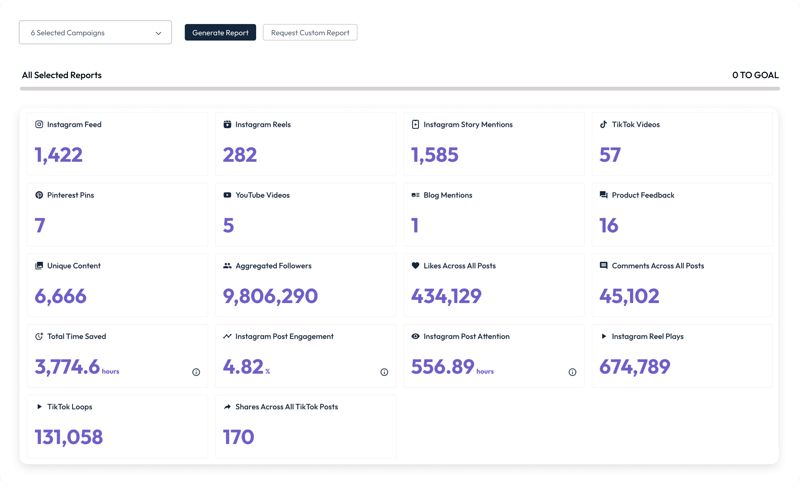
Spreadsheets are the go-to influencer reporting method for many brands. If you're not always using a dedicated platform or database, chances are you're already going the spreadsheet route.
Below is a sample influencer campaign report using our own tracking template:

But if you plan to work with influencers at scale, tracking KPIs with spreadsheets isn't realistic.
Sure, you might be able to keep your budget leaner. Consider the amount of lost time and productivity that comes with having to...
This is just a snapshot of why spreadsheets only work for brands managing a handful of influencers. The more posts you want, the more overwhelming the reporting process gets.
Again, this is all the more reason to integrate an influencer platform into your marketing stack.
From assessing “success” to understanding ROI, wrangling your campaign data is a must-do.
This rings true whether you want to optimize your current campaigns or get buy-in from stakeholders to scale in the future.
Whether you want to streamline your influencer marketing reporting or make it a hands-off task, Statusphere can totally help.
Our platform offers on-demand influencer analytics from your brand's campaign portal. Statusphere makes it super simple to pull reports on everything from complete and pending posts to time-saved and social engagement. All of your influencer performance, all in one place.
We eliminate any second-guessing your numbers or bouncing between platforms. Oh, and no more spreadsheets! Statusphere's advanced fulfillment technology also ensures that orders are tracked and shipped in a timely manner.
Want to learn more about how our platform works? Get in touch with one of our experts to see how we can streamline and scale your influencer marketing efforts in a fraction of the time.
This article was first published in July 2021. It was last updated June 2, 2023.

Influencer marketing trends change constantly in reaction to social media, consumers, and influencers themselves. Stay up-to-date with this trend...
Here's everything you should know when reporting influencer marketing ROI to your boss so you get the green light on your next campaign.
How do brands calculate the ROI of influencer marketing? This post breaks down ways to measure influencer marketing ROI and formulas to help.
Be the first to know about the latest tools, trends and strategies in influencer marketing for brands.